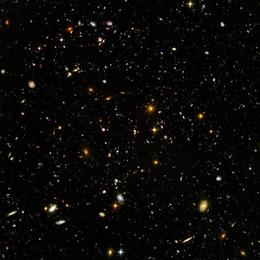|
Before the Big Bang: A Twin Universe?
April
09, 2008
The new study suggests that the universe that
came before our own universe was its identical twin. Image
credit: NASA and ESA

Until very recently, asking what happened at or
before the Big Bang was considered by physicists to be a
religious question. General relativity theory just doesn’t go
there – at T=0, it spews out zeros, infinities, and errors – and
so the question didn’t make sense from a scientific view.
The Theory of Everything - Read
new perspectives on quantum physics, relativity, and cosmology.
NewPhysicsAndTheMind.net
Universe of Luxury - Download
and Listen to the Universe of Luxury Podcast.
www.UniverseOfLuxury.com
Cheap Student Flights - Save
Now! Flight Discounts U.S. and Worldwide Exclusively for
Students
www.StudentUniverse.com
But in the past few years,
a new theory called Loop Quantum Gravity (LQG) has emerged. The
theory suggests the possibility of a “quantum bounce,” where our
universe stems from the collapse of a previous universe. Yet
what that previous universe looked like was still beyond
answering.
Now, physicists Alejandro
Corichi from Universidad Nacional Autónoma de México and
Parampreet Singh from the Perimeter Institute for Theoretical
Physics in Ontario have developed a simplified LQG model that
gives an intriguing answer: a pre-Big Bang universe might have
looked a lot like ours. Their study will appear in an upcoming
issue of Physical
Review Letters.
“The significance of this concept is that it answers what
happened to the universe before the Big Bang,” Singh told PhysOrg.com.
“It has remained a mystery, for models that could resolve the
Big Bang singularity, whether it is a quantum foam or a
classical space-time on the other side. For instance, if it were
a quantum foam, we could not speak about a space-time, a notion
of time, etc. Our study shows that the universe on the other
side is very classical as ours.”
The finding builds on
previous research, with some important differences. Last year,
Penn State physicist Martin Bojowald used a simplified version
of LQG to show that a universe “on the other side” of the bounce
could have existed. However, although that model produced valid
math, no observations of our current universe could have lead to
any understanding of the state of the pre-bounce universe, as
nothing was preserved across the bounce. Bojowald described this
as a sort of “cosmic amnesia.”
But Corichi and Singh have modified the simplified LQG theory
further by approximating a key equation called the quantum
constraint. Using their version, called sLQG, the researchers
show that the relative fluctuations of volume and momentum in
the pre-bounce universe are conserved across the bounce.
“This means that the twin universe will have the same laws of
physics and, in particular, the same notion of time as in ours,”
Singh said. “The laws of physics will not change because the
evolution is always unitary, which is the nicest way a quantum
system can evolve. In our analogy, it will look identical to its
twin when seen from afar; one could not distinguish them.”
That means that our
universe today, roughly 13.7 billion years after the bounce,
would share many of the same properties of the pre-bounce
universe at 13.7 billion years before the bounce. In a sense,
our universe has a mirror image of itself, with the Big Bang (or
bounce) as the line of symmetry.
“In the universe before the bounce, all the general features
will be the same,” said Singh. “It will follow the same
dynamical equations, the Einstein’s equations when the universe
is large. Our model predicts that this happens when the universe
becomes of the order 100 times larger than the Planck size.
Further, the matter content will be the same, and it will have
the same evolution. Since the pre-bounce universe is
contracting, it will look as if we were looking at ours backward
in time.”
Specifically, Corichi and Singh calculate that the change in
relative fluctuations across the bounce is less than 10-56,
a number which becomes even smaller for universes that grow
larger than 1 megaparsec (our universe is somewhere between
3,000 and 6,000 megaparsecs).
As the researchers explain, having an identical twin universe
would not necessarily mean that every single feature of both
universes would be identical. For instance, it doesn’t imply
that there was another you that existed at some point, a person
who has already lived your life.
“If one were able to look at certain microscopic properties with
a very strong microscope – a very high-energy experiment probing
the Planck scale – one might see differences in some quantities,
just as one might see that twins have different fingerprints or
one has a mole and the other does not, or a different DNA,”
Singh said.
As Singh explained, there are still many questions regarding the
details of the possible pre-bounce universe.
“The biggest question is whether these features survive when we
consider more complex situations,” he said. “For example, one
would like to know whether some structures present in the
previous universe – like galaxies – will leave some imprint in
the new expanding one that will give rise to identical structure
or just 'similar.' For instance, it could happen that, in the
previous universe, galaxies formed in a different way, so one
might have a different distribution of galaxies on the other
side. We will be able to answer this question when we understand
these models.”
Ultimately, Corichi and Singh’s model might even tell us what a
future universe would look like. Depending on how fast our
present universe is accelerating – which will ultimately
determine its fate – there’s a possibility that a generalization
of the model would predict a re-collapse of our own universe.
“Such a universe will have many bounces from one branch to
another,” Singh said. “It is also possible that universes in
different branches will be identical.”
Source
http://www.physorg.com/news126955971.html
1 2 3 4 5 6 7 8 9 10 Newest
articles
|
